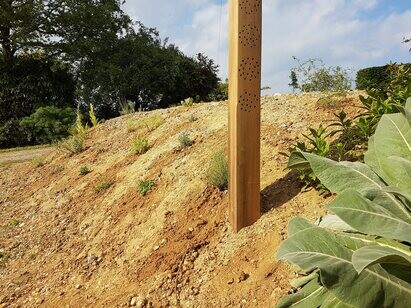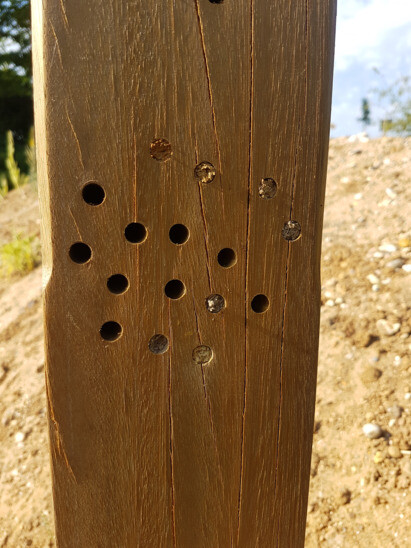Find out what the garden and propagation teams have been up to this week.

The Sand Bank
Following the removal of two large Leyland cypress trees and a few old shrubs from the Gravel Garden, a substantial area was made available for replanting. After our usual thorough overwinter soil preparation of deep digging and adding organic matter, this area was planted in May 2021 with the plants establishing extremely well over the summer.

Bank being cleared
Just behind this area, not visible from the Gravel Garden, the ground falls away down a dry, sunny, and steep west facing bank. This presented the ideal opportunity to experiment with a slightly less intensive approach to growing drought resistant plants. No deep digging, no adding organic matter, and no mulching, as we had done at the top of the bank. Rather, we decided to simply clear the bank of any persistent plants and roots, rake over the soil and cover it in a layer of sand. Which sand to use was debated for a while, until we realised that we had a pile of sand and gravel, ballast in effect, dug out from elsewhere on site to use, so a very local material! with no transport issues and no cost. This aggregate was spread over the bank to a depth of between 15-30cm (6-12 inches).

Planted in early June 2021
A rather random selection of drought-resistant plants was chosen and planted in early June (see list at end of article). It was decided not to have to many ground-cover types, instead using small shrubby or clump forming plants with the idea that the bare sand would encourage any ground nesting solitary bees. Many practitioners of sand gardening will use small plants and wash all compost from the roots, but we simply selected the plants from our nursery, which are grown in peat-free compost and planted as normal. As is our usual practice the plants were watered just once after planting and left to establish (or not)!

View of the entire area replanted
Rather worryingly a warm dry spell followed during the rest of June, and the surface of the ballast dried out, but underneath it remained moist and loose, allowing the plant roots to get a hold. Often at the beach, sand is loose and dry on top, but dig down a bit and you soon find dampness, and this is what the plant roots search for. Another major bonus has been the lack of weeds, any that do germinate are easily extracted from the loose sand with the minimum of effort.
Slowly but surely, in contrast to the relatively lush growth above the bank, the plants have established, with only a couple of losses. Particularly pleasing is our native sea holly, Eryngium maritimum, which was tiny on planting, but appears to have forced its fleshy roots down, just as it would on our local North Sea coast. Interestingly this sea holly has always struggled in the main Gravel Garden, which is possibly too dry? holding less moisture during summer than a depth of sand. Now, we must see how these plants cope with the winter.

Holes sealed by red mason bees
Our good friend John Little, a major advocate of growing plants in low fertility substrates https://www.grassroofcompany.co.uk/ kindly donated a bee post made from reclaimed greenheart, a dense tropical hardwood originally used in the construction of the London docksides, and since reclaimed. Drilled with various size holes, from 2-10mm in diameter, the pole was placed a couple of weeks prior to planting and almost immediately red mason bees started nesting in the larger holes, with leaf cutter bees and resin bees moving in later. The sand itself does not appear to have attracted too much obvious activity, possibly it’s not ideal, as the surface caps quite easily in dry weather. John recommends we try Thanet sand, which might be more to the bees liking.


November 2021
Whilst only in its infancy, this small trial has given us some confidence to continue to explore this form of gardening in conjunction with a more traditional approach. Don’t forget, we are in the driest part of the UK! Could this evolve into a sustainable and diverse model for urban planting? It’s an interesting thought!
Dave Ward. November 2021.

Frankenia thymifolia and Teucrium ackermannii
List of plants used on the Sand Bank. Click on the plant for more information.
Name / pot size |
Dianthus arborescens ex. Nopigia, N.W Crete |
Helictotrichon sempervirens yellow foliage form |
Lavandula x chaytoriae 'Sawyers' 1L |
Lomatium grayi |
Lygeum spartum 1L |
Rhodiola fastigiata |
Rhodiola linearifolia |

COMMENTS